Lal R., Shukla M.K. Principles of Soil Physics
Подождите немного. Документ загружается.

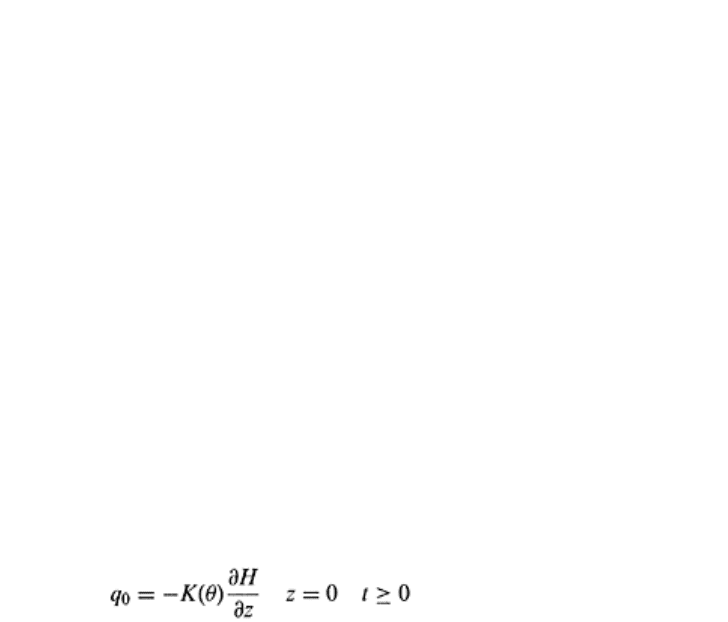
14.7 UNSTEADY INFILTRATION
There are numerous situations under field conditions when the infiltration rate is
unsteady, transient, or instantaneous. It never attains a steady state condition.
14.7.1 Dirichlet’s Boundary Condition
The soil surface remains saturated (θ=s=1) as long as water is ponded on it. If the depth
of ponding is small (d→0), only the surface soil remains saturated. Such a situation is
defined as Dirichlet’s boundary condition (DBC) for infiltration into semi-infinite
homogeneous soil (Kutilek and Nielsen, 1994). Mathematically DBC can be represented
by Eqs. (14.49) to (14.51):
t≥0 z=0 θ=θ
s
(14.49)
or
t≥0 z=0 Φ
m
=Φ
m0
(14.50)
t≥0 z=0 Φ
m
=0
(14.51)
and
t=0 z>0 θ=0
(14.52)
The boundary condition specified by Eq. (14.49) is employed when the diffusivity form
of Richards’ equation is used [see Eq. (13.23)]. The boundary conditions (14.50) and
(14.51) are used with capacitance form of Richards’ equation [see Eq. (13.21)]. The
condition (14.52) is the initial condition. Equations (14.50) and (14.51) have the
advantage that it specifies the depth of ponding of water on soil surface. DBC is
applicable on the infiltration data obtained through double ring infiltrometer. The
infiltration rate by a double ring infiltrometer is measured either by measuring the fall of
water in the inner ring or the fall of water in a Marriotte bottle used to maintain a constant
head in the inner ring. The role of outer ring is limited to keep the divergence of flow
paths in inner cylinder to a minimum.
14.7.2 Neumann’s Boundary Condition
While describing the rainfall distribution, it is assumed that rainfall is evenly distributed
on the entire soil surface and the rainfall flux density passes either partially or fully
through the soil surface. The boundary condition for such a situation is described by
Darcy–Buckingham equations [Eqs. (14.53) and (14.54)]
(14.53)
Principles of soil physics 394

(14.54)
Equation (14.54), which is also the diffusivity form of the Darcy– Buckingham equation,
is known as Neumann’s boundary condition (NBC), and is used to describe the rainfall or
sprinkler infiltration. For these experiments regardless of how NBC is achieved the initial
condition is kept the same as that for DBC (see Sec. 14.71).
14.8 SOIL WATER REDISTRIBUTION
After the cessation of infiltration, it is commonly observed that moisture content of the
topsoil gradually decreases, even when the topsoil is covered and evaporation is either
nonexistent or insignificant. Downward movement of water in the soil profile
accompanies the decrease in moisture content of topsoil. In the absence of a water table,
this phenomenon, where wetted topsoil wets the drier subsoil, is known as “soil moisture
redistribution”. It is defined as the continued movement of water through a soil profile.
However, in case a shallow water table exists, the phenomenon is known as “drainage to
groundwater”.
Water distribution is a complex process, as topsoil loses water and becomes drier
while subsoil gets wetter. Therefore, soil-moisture hysteresis (refer to Chapter 11) may
have important influence on the shape and dynamics of moisture content profile.
Figure 14.10 shows the schematic of a typical soil moisture redistribution curve after
an irrigation or rainfall event. Once the rainfall or irrigation is stopped, the soil moisture
potential from surface up to the wetting front is close to zero (θ=s=1). Immediately below
the wetting front the value of soil moisture potential is very low, thus a large gradient
exists between wetting front and dry soil. Therefore, the waterfront starts moving
downward and the moisture content of the surface profile gradually
FIGURE 14.10 Schematic of water
content redistribution cycles following
a rainfall or irrigation event.
Water infiltration in soil 395
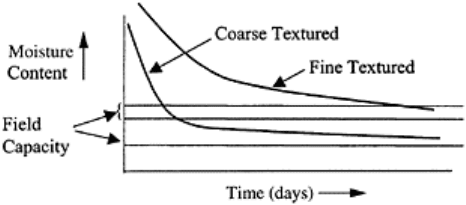
decreases. There is no abrupt change in moisture content of top profile. As surface drying
proceeds, the waterfront gradually moves downwards. The waterfront creates a sharp
continuous boundary between the wet region and the dry soil. The shape of the water
profile is very close to being called a rectangle, with a height equal to the thickness of
wetted profile and width equal to the difference in moisture content between wet and dry
regions. As the moisture content is fairly uniform within the wetting front, the flow can
be described as gravity-driven flow.
As moisture content of wetted region continuously decreases and moisture content of
drier region increases, the soil profile tends to move towards equilibrium. The rate of
decrease of moisture content depends upon the depth of the original wetting front,
gradient, and hydraulic conductivity of soil. As soil-moisture potential decreases the
gradient also decreases and hydraulic conductivity also decreases simultaneously. The
schematic of the waterfront positions after 3 days, 10 days, and 24 days are shown in Fig.
14.10.
14.9 FIELD WATER CAPACITY
The moisture content at which the internal drainage completely ceases is known as the
field moisture capacity of soil (refer to Chapters 10 and 11). The field moisture capacity
is an arbitrary and not an intrinsic physical property of a soil. A working definition of
field capacity is the moisture content two days after infiltration or rainfall event. The field
capacity concept can be easily applied to coarse textured soils where an initially high
infiltration and redistribution slows down considerably owing to the large decrease in
hydraulic conductivity than in fine textured soils, where slow but
FIGURE 14.11 Schematic of decrease
in water content with respect to time
for an initially wetted sail profile
during redistribution.
appreciable amount of water movement can persist for a much longer duration (Fig.
14.11). Field capacity of soil is a function of soil texture, type, and amount of clay
content, organic matter content, antecedent soil moisture status, evapotranspiration, depth
of impervious layer, and depth of wetting of soil profile. Richards et al. (1956) proposed
Principles of soil physics 396

the following equation for calculating the decrease of moisture content with respect to
time [Eq. (14.55)]
(14.55)
where W is the moisture content of soil profile, t is time, and a and b are constants related
to the conductance properties of soil and boundary conditions, b is also related to soil
diffusivity.
14.10 MEASUREMENT OF INFILTRATION
Under laboratory conditions, infiltration is measured using soil columns with the Mariotte
bottle technique (Fig. 14.12). The infiltration may be measured in either vertical or
horizontal columns. The cumulative infiltration is expressed in units of cm (volume of
water read from a Mariotte bottle divided by the cross section area of soil column).
Infiltration rate under field conditions can be measured by a double ring infiltrometer
under positive pressure head (Fig. 14.13). The infiltration rate under tension can be
measured by a tension infiltrometer. Details on various infiltrometer, are presented by
Perroux and White (1988), Everts and Kanwar (1992). If the soil has a low infiltration
rate, the change in height of water can also be measured using a water stage recorder
(Fig. 14.14). Under field conditions, infiltration rate may also be measured using a
rainfall simulator (Fig. 14.15). Different types of rainfall simulators are explained by
Meyer (1994).
Water infiltration in soil 397
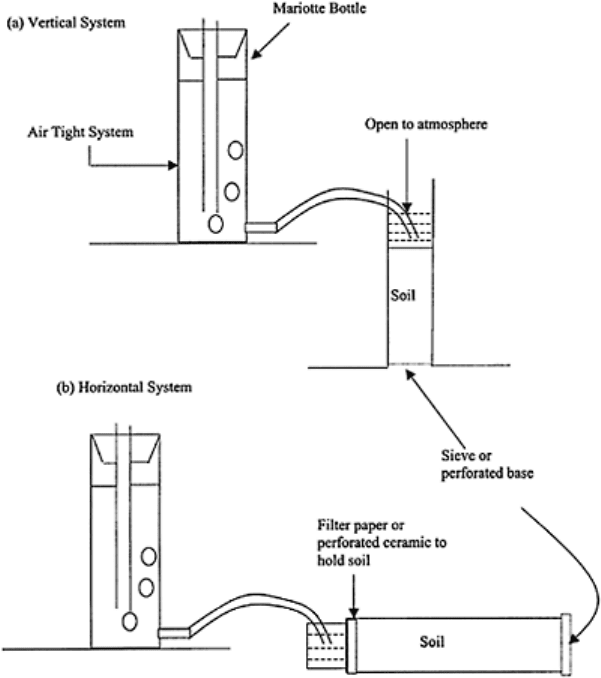
FIGURE 14.12 Measurement of
infiltration in soil columns using a
Marriotte bottle technique.
14.11 MANAGEMENT OF INFILTRATION
The infiltration into a soil profile is a function of structural and textural properties, and
soil moisture of a soil. The land use and soil management practices have a profound
influence on the infiltration of water into the soil profile (Lal and Vandoren, 1990;
Shaver et al., 2002; Shukla et al., 2003a; b). Tillage practices (Fig. 14.16), which alter
soil structure and increase porosity of the upper layer, enhance the initial infiltration into
Principles of soil physics 398
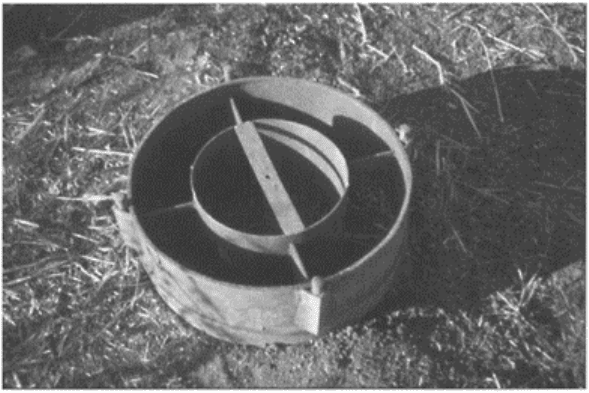
FIGURE 14.13 A double ring
infiltrometer. The outer ring is 30–50
cm in diameter and the inner ring 20–
30 cm. Both rings are 20 to 30 cm
high.
Water infiltration in soil 399
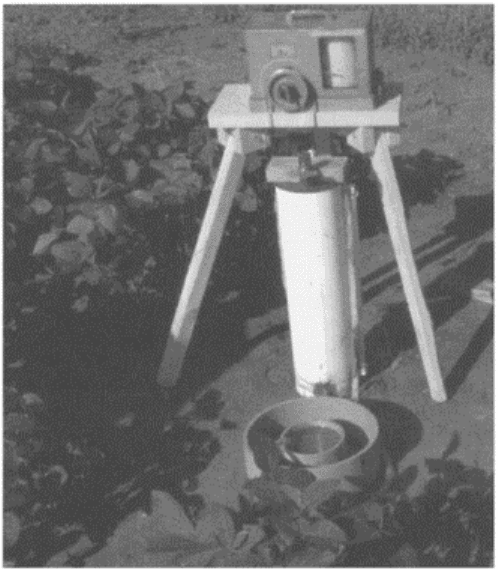
FIGURE 14.14 The change in height
of water in a column used to assess
infiltration can also be measured using
a water stage recorder.
Principles of soil physics 400
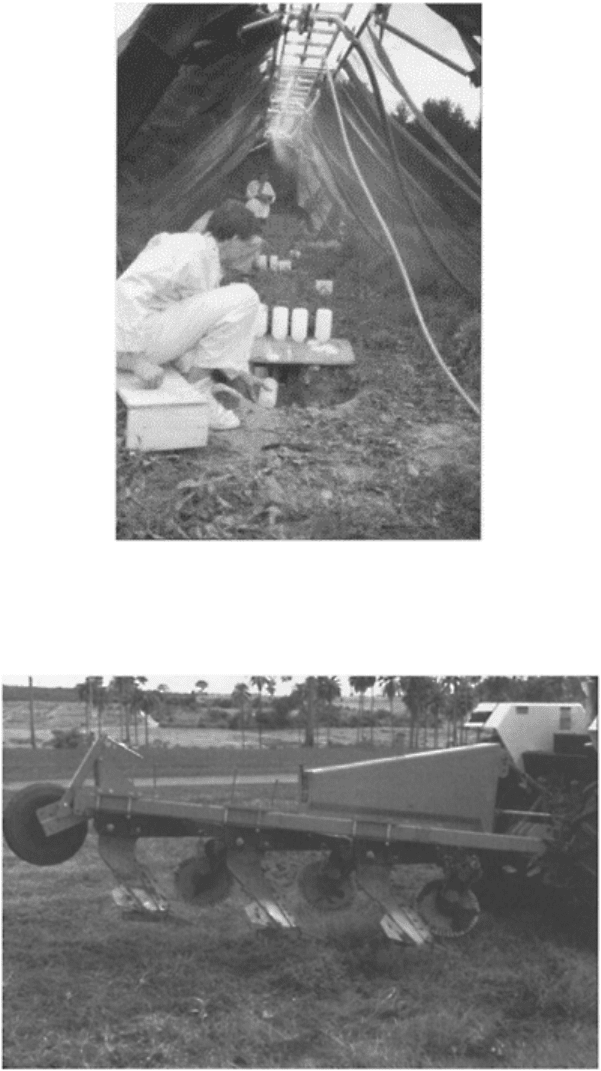
FIGURE 14.15 Rainfall simulators are
commonly used to assess infiltration
rate under nonponded condition.
Water infiltration in soil 401

FIGURE 14.16 Para plow can
alleviate compaction without causing
inversion.
FIGURE 14.17 Residue mulch and
no-till farming enhance infiltration rate
in soil.
Principles of soil physics 402

FIGURE 14.18 Furrow irrigation
increases water infiltration into the
root zone.
the soil. However, subsoil compaction often results in a net decrease in total infiltration.
The mulching affects both physical and chemical properties of soil. Mulching controls
soil erosion by avoiding the direct impact of a raindrop on soil surface, decreasing the
runoff rate and increasing infiltration of rainwater (Fig. 14.17). Furrow irrigation is
practiced to enhance water infiltration in the root zone (Fig. 14.18). The notill farming
practices with mulching also increase the infiltration rate of soil. The soil remains
undisturbed with respect to the farming operations and this results in enhanced worm
activities in the soil (Butt et al., 1999). No-till also improves soil aggregation, which
increases the total porosity of soil. All these factors not only result in more aeration but
also in high infiltration rate of irrigation or rainwater through larger pores around
aggregates and macropores or biopores formed by earthworms.
Example 14.1
The infiltration rate was measured in a no-till silt loam soil with corn and soybean
rotation as given in the following table. The data in first three columns are given.
Calculate the (a) depth of actual infiltration, (b) cumulative infiltration, (c) infiltration
rate, (d) parameters of the Green and Ampt equation (14.17) and the Philip equation
[(14.26) and (14.27)].
Solutions
(a) The actual depth of infiltration is given in column (5)
(b) The cumulative depth of infiltration is given in column (6)
(c) Infiltration rate is given in column (9)
T
(min)
Reading in
infiltrometer
(cm)
Water
filled
upto
(cm)
dT
(min)
Infiltration
I(cm)
Cumulative
infiltration
CI (cm)
CI
−1
t
(−1/2)
dI/dt
(cm/min)
1 2 3 4 5 6 7 8 9
0 1 0 0 0 0 0
2 3 2 2 2 0.500 0.707 1.000
5 5.2 1 3 2.2 4.2 0.238 0.447 0.733
10 4 5 3 7.2 0.139 0.316 0.600
15 6 1 5 2 9.2 0.109 0.258 0.400
25 5.2 1 10 4.2 13.4 0.075 0.200 0.420
35
48
1
10
38
17 2
0 058
0 169
0 380
Water infiltration in soil 403
